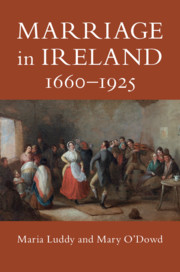Book contents
- Marriage in Ireland, 1660–1925
- Marriage in Ireland, 1660–1925
- Copyright page
- Dedication
- Contents
- Figures
- Illustrations
- Tables
- Acknowledgements
- Abbreviations
- Introduction
- Part I What Is a Marriage?
- 1 A Legal Marriage?
- 2 Couple Beggars
- Part II Ways to Marriage
- Part III Happy Ever After?
- Part IV The Unmaking of Marriage
- Conclusion
- Select Bibliography
- Index
2 - Couple Beggars
from Part I - What Is a Marriage?
Published online by Cambridge University Press: 04 June 2020
- Marriage in Ireland, 1660–1925
- Marriage in Ireland, 1660–1925
- Copyright page
- Dedication
- Contents
- Figures
- Illustrations
- Tables
- Acknowledgements
- Abbreviations
- Introduction
- Part I What Is a Marriage?
- 1 A Legal Marriage?
- 2 Couple Beggars
- Part II Ways to Marriage
- Part III Happy Ever After?
- Part IV The Unmaking of Marriage
- Conclusion
- Select Bibliography
- Index
Summary
Couple beggars were unattached clergymen who performed marriages for payment in eighteenth and early nineteenth-century Ireland. The term ‘couple beggar’ was used to refer to a diverse range of men.It included Catholic priests, Church of Ireland ministers and Presbyterian ministers. A marriage conducted by a clergyman ordained by a bishop was legal under most circumstances. Most couple beggars had fallen out with their respective churches for a variety of offences usually involving women or alcohol.Some couple beggars continued to hold official clerical positions but were not averse to marrying couples privately for cash payments.The popularity of couple beggars in Ireland before 1850 was a natural corollary to the absence of statute law defining how, where and by whom a marriage should be celebrated.Many couple beggars developed a flourishing business particularly in the late eighteenth and early nineteenth century when there was considerable ambiguity around what constituted a legally valid marriage.The Marriage Ireland Act of 1844 and its amendment put Church of Ireland and Presbyterian couple beggars out of business because it specified that marriages presided over by a Church of Ireland or Presbyterian minister must take place in a church or meeting house registered with the newly appointed Registrar.
Keywords
- Type
- Chapter
- Information
- Marriage in Ireland, 1660–1925 , pp. 62 - 88Publisher: Cambridge University PressPrint publication year: 2020

